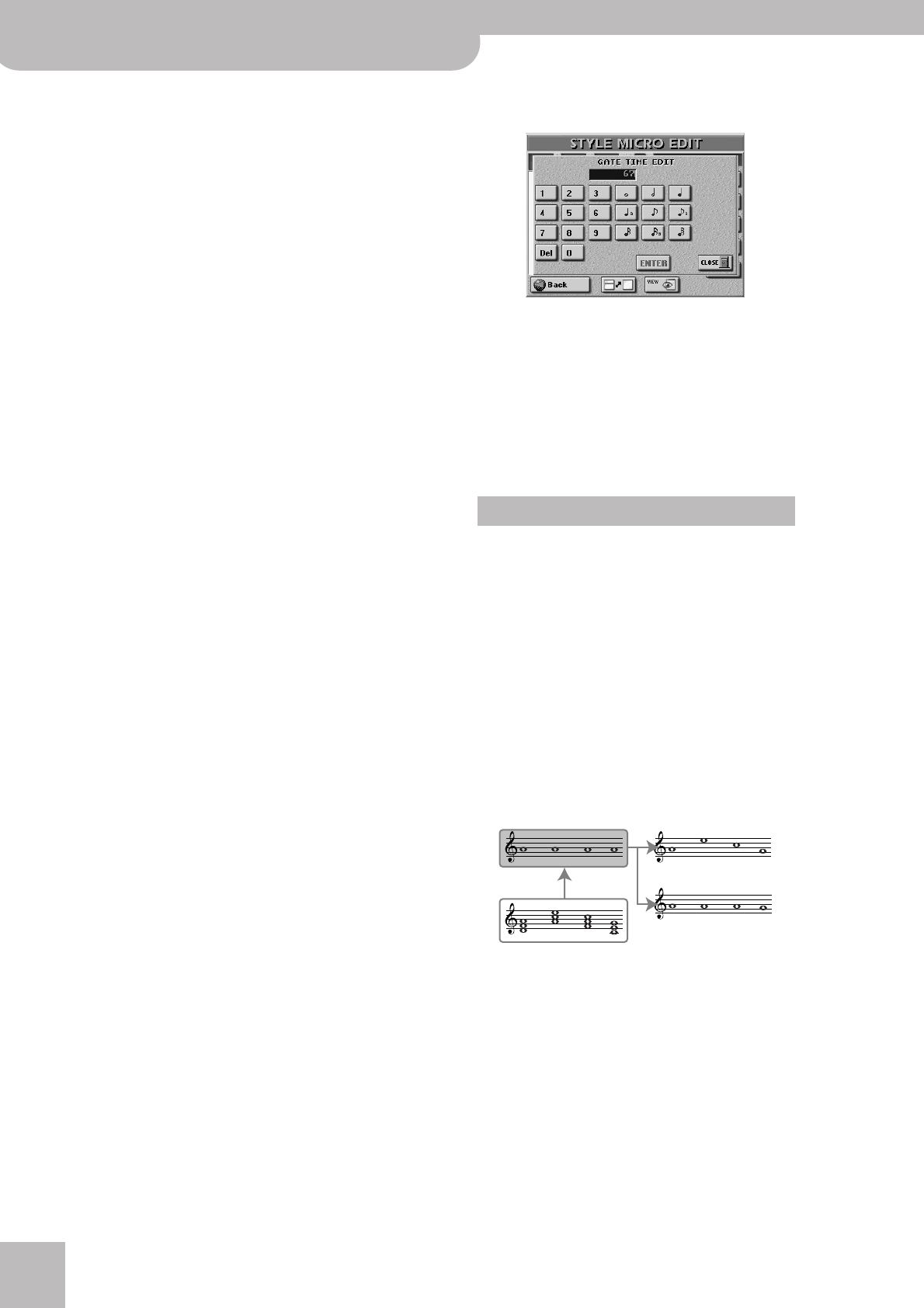
Programming Styles (Style Composer)
222
r
E-80 Music Workstation
Note: CC64 (Hold) events generated by a footswitch con-
nected to the HOLD FOOTSWITCH socket are converted into
the equivalent GATE TIME values at the time of recording.
You may therefore have to change the duration of the notes
themselves.
● Program Change—These messages are used to select
sounds within the current bank. As there are only 128
possibilities, these messages are usually preceded by
control changes CC00 and CC32. That’s why the E-80
inserts all three when you use the CREATE EVENT func-
tion.
Note: The CC00 value of ADrums tracks cannot be edited.
● Pitch Bend—These messages are used for temporary
changes to the pitch of the notes being played at that
time. Pitch Bend messages can be positive (higher) or
negative (lower). Setting range: –128~128.
● Alteration Mode—This is a new event that allows you to
specify how the notes recorded for a Style track will be
used during Arranger playback. See below for details.
Note: This parameter is not available for ADrums tracks.
● NRPN Dr—This NRPN command is only available for
ADrums tracks. It inserts CC99 with the value “24”,
CC98= “37” as well as CC06= “64”. While the CC99 value
cannot be changed, the CC98 value can be set to: 37, 38,
40, 41, 52, 56, 57 or 65 (these are note numbers of the
drum sounds whose pitch can be changed). The CC06
value (which changes the pitch) can be set to 0~127,
whereby “64” means that the pitch remains unchanged.
Editing events
■Editing Pitch Bend messages
Pitch Bend messages can be positive or negative (the
range is –128~128). The value “0” means that the
pitch of notes being played in that area is not altered.
If a Pitch Bend occurrence is not reset to “0” at some
stage, all notes will keep sounding flat when you no
longer want them to.
■Editing control changes
These messages (CC) can be set to the desired value
(0~127) when the corresponding effect is needed –
but they also need to be reset to “0” to avoid
unpleasant surprises.
■About the “Note” messages
As stated above, note messages comprise a note
number, a velocity value and a Gate Time value.
The range for note numbers is “0 (C–)”~“127 (G9)”.
Velocity messages can be set anywhere between “1”
(extremely soft) and “127”. The value “0” cannot be
entered, because it would effectively switch off the
note.
After selecting a Gate Time entry, pressing the
[DATA÷ENTRY] dial calls up the following pop-up:
Here, you can either set the required length as a CPT
value (q= 120CPT) or use the note fields to avoid
lengthy calculations. Use the numeric pad to enter
the desired duration. Drum parts usually use the Gate
Time value “1” for all notes. Increasing it to “20”, for
example, has no audible effect on the sound dura-
tions. The maximum duration a note event can have
is 99,999 clocks, which corresponds to roughly 208
bars.
This message type is only available for melodic Style
tracks (i.e. not for ADrums or ABass tracks) and needs
to be inserted by hand (using CREATE EVENT). Style
tracks you only just recorded do not contain it.
It allows you to use a revolutionary system for adapt-
ing the recorded notes to a more natural behavior
(also known as “voicing”). There are two options:
● Degree—This setting refers to the “old” system for real-
time conversion of Style track information for Style
playback. Based on the fundamentals of the chords you
play during Arranger playback, it often leads to odd
jumps of certain parts.
● Nearest—Refers to a new, more musical, system for real-
time shifts of the recorded Style notes during Arranger
playback. Let us first look at an illustration:
This new system is called “Adaptive Chord Voicing”. The
notes of the melodic Style tracks are compared against the
chords played in the recognition area. If the next chord you
play contains the note the selected part is already sounding
(based on the previous chord), that note is maintained.
If the new chord does not contain that note, the Style part
in question uses the closest (“Nearest”) note. In the exam-
ple above, the “G” is closer to the “A” sounded by the
strings part than the “C”. This produces a more musical
behavior than any other system on the market.
About “Alteration Mode” messages
Recorded strings track
Chords played in the recognition area.
Result with “Degree”
Result with “Nearest”
